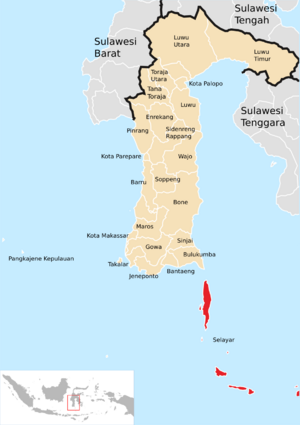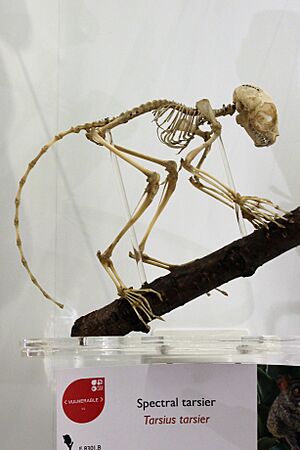Spectral tarsier facts for kids
Quick facts for kids Spectral tarsier |
|
|---|---|
| Conservation status | |
| Scientific classification | |
| Genus: |
Tarsius
|
| Species: |
tarsier
|
 |
|
| Spectral tarsier (Tarsius tarsier) range in Selayar Islands | |
The Spectral tarsier or Selayar tarsier (Tarsius tarsier, also known as Tarsius spectrum) is a small, furry animal. It is a type of tarsier found on Selayar Island in Indonesia. This tarsier seems less specialized than its relatives, like the Philippine tarsier. For example, it does not have sticky toes.
The Spectral tarsier is the main example for the Tarsius group of animals. In the past, tarsiers living on nearby southwestern Sulawesi were thought to be the same species. However, scientists have now decided they are a separate species called Tarsius fuscus. Some older studies about Tarsius spectrum actually included these now-separate tarsiers. One of these is the Gursky's spectral tarsier (Tarsius spectrumgurskyae).
Contents
What Are Tarsiers?
Scientists once thought tarsiers were related to lemurs and lorises. This was because they look similar and are also active at night. But now, we know tarsiers are part of a group called Haplorhini. This group includes tarsiers and monkeys and apes.
Research shows that tarsiers are more closely related to monkeys and apes than to lemurs. Some experts even suggest dividing the tarsier group into three different types. This idea is supported by looking at things like their fur color, tail length, and size. It is also supported by studying their DNA.
How Do Spectral Tarsiers Look?
The Spectral tarsier is a small creature. It weighs about 200 grams. Its body is about 80 millimeters long, and its tail is about 160 millimeters long. This makes its total length around 240 millimeters.
Female tarsiers weigh between 102 and 114 grams. Males are a bit heavier, weighing from 118 to 130 grams. Their head and body together measure about 9.5 to 14 centimeters. Their tail can be quite long, ranging from 20 to 26 centimeters.
Where Do Spectral Tarsiers Live?
Tarsiers live in different types of forests. These forests can be dense or more open. They live on various islands. They can be found in both untouched forests and forests that have been regrown.
They like to rest in thick plants. This includes shrubs, bamboo, and palm trees. They also hide in dense grass, bushes, and thorny areas. Sometimes, they live in areas where people grow crops like coffee, nutmeg, or coconut.
What Do Spectral Tarsiers Eat?
Tarsiers have a very special diet for a primate. They are completely carnivorous, meaning they only eat meat. While some tarsiers might hunt small birds or rodents, their main food is insects.
They catch insects on the ground, on tree branches, and on leaves. They are also good at catching insects flying in the air.
How Do Spectral Tarsiers Behave?
Spectral tarsiers are nocturnal animals. This means they are active at night. They wake up when the sun sets. They spend their nights hunting for insects and eating.
They move between trees and spend time together. This often includes grooming each other. They also mark their territory with scents. Sometimes, they play and make sounds to communicate.
Tarsier groups have different roles for males and females. Males usually travel farther and cover a larger area. Females are better at hunting and eat more insects. A group of tarsiers usually has 2 to 6 members. These are the individuals who share a sleeping spot.
Some tarsier groups can have more than one adult female. In one study, two females in a group both had babies. Tarsiers can live in pairs or in larger groups. Some males might even live alone.
Spectral Tarsier Life Cycle
In one study, scientists found that spectral tarsiers were monogamous. This means they had only one partner. They also defended their territory. Families would sleep in the same spots every day. They would sing loud songs together when they gathered at their sleeping places.
Baby tarsiers develop quickly. They can start traveling alone when they are as young as 23 days old. Another study found that baby tarsiers were often alone. Older young tarsiers, called subadults, often cared for the babies. They seemed to be guarding or babysitting them.
How Long Do Spectral Tarsiers Live?
In the wild, spectral tarsiers are thought to live for about 10 years. However, a similar tarsier species has lived up to 17 years in zoos. Scientists think spectral tarsiers might live just as long.
It is believed that tarsiers start showing signs of old age around 14 to 16 years old. Just like people, their hair might start to turn gray.
How Do Spectral Tarsiers Communicate?
Spectral tarsiers use special sounds to communicate. These are called ultrasonic vocalizations. They are very high-pitched sounds that humans cannot hear. These sounds can only travel short distances.
Scientists think tarsiers use these sounds for echolocation. This helps them find their way around in the dark. There are five main types of sounds they make: chirps, twitters, choruses, doubles, and whistles. Some of these sounds can be heard by humans, but others are pure ultrasound.
Tarsiers also use high-pitched whistles and duets. Duets sound like chattering songs. High-pitched whistles can be simple calls or warnings about predators. If there is a bird predator, tarsiers will make sounds and hide. If there is a land predator, like a snake, they might work together to scare it away. This is called mobbing. Mobbing means all the tarsiers in an area respond to a threat. They make sounds and repeatedly lunge at the predator, then back away.
What Are Natural Threats to Tarsiers?
Tarsiers mark their territory by rubbing branches with their urine. They also use special glands on their stomach. The main animals that hunt tarsiers are monitor lizards, civets, snakes, and different kinds of birds of prey.
Tarsiers play an important role in their environment. They affect the number of insects they eat. They also affect the number of animals that eat them. Tarsiers can also have many parasites, like mites and worms, living on or inside them.
How Humans Affect Spectral Tarsiers
Conservation Status
In 1998, a scientist suggested that the Spectral tarsier's conservation status should be changed to vulnerable. This means they are at risk of becoming endangered. Today, the Spectral tarsier is still listed as vulnerable on the IUCN Red List.
Losing their homes and deforestation (cutting down forests) causes the number of tarsiers to go down. Luckily, tarsiers now live in many protected areas.
Images for kids





